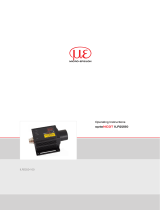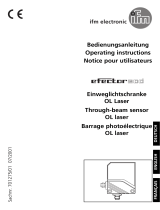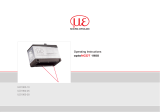
Operating instructions
Diffuse reflection sensor with
background suppression
OJ50xx laser
11494934 / 00 05 / 2010
UKUK

2
Contents
1 Preliminary note....................................................................................................3
1.1 Symbols used .................................................................................................3
2 Safety instructions ................................................................................................3
3 Functions and features .........................................................................................4
4 Installation ............................................................................................................4
4.1 Mounting positions .........................................................................................5
4.2 Installation of the supplied mounting fixture ...................................................6
5 Electrical connection.............................................................................................6
6 Settings.................................................................................................................7
6.1 Setting of the sensitivity with stationary objects* ............................................ 7
6.2 Setting of the maximum sensitivity* ................................................................8
6.3 Electronic lock ................................................................................................8
6.4 Programming the output function* .................................................................. 8
7 Operation ..............................................................................................................9
8 Maintenance, repair and disposal.........................................................................9

3
UK
1 Preliminary note
1.1 Symbols used
►Instruction
> Reaction, result
→Cross-reference
Important note:
Non-compliance can result in malfunctions or interference.
Information
Supplementary note.
2 Safety instructions
According to the cULus approval
Caution - Use of controls or adjustments or procedures other than those specified
herein may result in hazardous radiation exposure.
Visible laser light; CLASS 1 LASER PRODUCT.
IEC 60825-1 : 2007
Complies with 21 CFR 1040.10 except for deviations pursuant to Laser
Notice No. 50, dated June 2007.
Position of the product label Additional label
Beispiel OJ5058

4
3 Functions and features
The diffuse reflection sensor detects objects and materials without contact and
indicates their presence by a switching signal.
Range: → type label (value referred to white paper 200 mm x 200 mm).
4 Installation
Side lens* Front lens*
21 1
2
1: LED
2: pushbutton
* In the following sections installation and setup are described using the example of the type
with front lens. The functions of the units with side lens are identical.
►Align the diffuse reflection sensor to the object to be detected and secure it to
a bracket.
Maximum range is only possible with precise alignment.
► Mount the unit so that the mounting position cannot change (avoid high
vibrations!).
Laser units with a very small light spot diameter are highly focussed; the
slightest change in the mounting position will result in misalignment.
The optical position of the laser beam may deviate slightly from the mechanical
axis. Therefore we recommend using the fine adjustment units E20975 (front lens)
or E20976 (side lens) when mounting the laser units.

5
UK
The objects to be detected are to move transversally to
the lens of the sensor.
►In case of other directions of movement it should be
tested before whether safe switching is guaranteed.
4.1 Mounting positions
For demanding applications (small distance between the object and the back-
ground) we recommend the following mounting positions:
Reflective background
►In case of highly reflective background surfaces and
less reflective object surfaces the sensor should be
mounted vertically to the background surface.
Reflective object
►In case of highly reflective object surfaces and less
reflective background surfaces the sensor should be
mounted at an angle of approx. 5 to 10°.

6
4.2 Installation of the supplied mounting fixture
►Secure the mounting fixture with the screws supplied, then slide the unit into the slot of
the fixture until the spring clicks home.
►To remove the unit press the spring down with a screwdriver and slide the unit out.
5 Electrical connection
The unit must be connected by a qualified electrician.
►The national and international regulations for the installation of electri-
cal equipment must be adhered to.
►Voltage supply according to EN 50178.
►Disconnect power.
►Connect the unit as follows:
DC PNP DC NPN
L
L+
3
2
4
1
teach
L
L+
3
2
4
1
teach
Programming of the output function by pushbutton or programming wire
(→ 6.4
Programming the output function
)
.

7
UK
6 Settings
6.1 Setting of the sensitivity with stationary objects*
1
Go into the programming mode of the unit.
►Press for about 2 s until the red
LED flashes.
> The red LED goes out; the yellow and green LEDs flash alternately.
> The unit is in the programming mode.
2
Set the sensitivity with object.
►Press once.
> The yellow and green LEDs go out for approx. 1 s, then flash again alternately.
3
Set the sensitivity without object.
►Press once.
> The yellow and green LEDs go out for approx. 1 s.
> After approx. 3 s the green LED is on.
> The unit is in the operating mode.
Setting steps 2 and 3 can also be carried out in reverse order.
* The sensitivity can also be set in exactly the same way using the programming wire
(pin 2 / WH). To activate the functions the programming wire is connected to L+ (pin 1 / BN)
for PNP units or to L- (pin 3 / BU) for NPN units for the appropriate time. Feedback: If setting
was not successful via the programming wire, the output will switch for 2 s. The unit then
passes into the operating mode with the sensitivity being unchanged.

8
If the setting of the sensitivity is not possible (e.g. object signal and back-
ground signal are about the same), the red LED flashes after step 3 for ap-
prox. 2 s. The unit then passes into the operating mode with the sensitivity
being unchanged.
If the setting button is not activated for 15 minutes during the programming
process, the unit passes automatically into the operating mode with the
sensitivity being unchanged.
6.2 Setting of the maximum sensitivity*
► Go into the programming mode of the unit. (→ step 1).
► Align the unit so that no light is reflected (min. distance > max. range).
► Press the setting pushbutton twice (steps 2 and 3).
* The maximum sensitivity can also be set in exactly the same way using the programming
wire (pin 2 / WH). To activate the functions the programming wire is connected to
L+ (pin 1 / BN) for PNP units or to L- (pin 3 / BU) for NPN units for the appropriate time.
6.3 Electronic lock
Activate the lock by connecting the programming wire for about 15 s -20 s*.
De-activate the lock by connecting the programming wire again for 15 s - 20 s*.
* To activate the functions the programming wire (pin 2 / WH) is connected to L+ (pin 1 / BN)
for PNP units or to L- (pin 3 / BU) for NPN units for the appropriate time.
6.4 Programming the output function*
►Press for 10 s.
> The red LED starts to flash fast after 2 s.
> Then the yellow and green LEDs flash
alternately.
> After 10 s all LEDs go off, the output
function has changed from light-on mode
to dark-on mode (or vice versa).
* The output function can be programmed in exactly the same way using the programming
wire (pin 2 /WH). To activate the functions the programming wire is connected to
L+ (pin 1 / BN) for PNP units or to L- (pin 3 / BU) for NPN units for the appropriate time.

9
UK
7 Operation
►Check whether the unit operates correctly.
> Display by LEDs.
Green LED on Unit is ready for operation.
Yellow LED on Output is switched.
LEDs yellow + red
Flash alternately, 2 Hz: output short-circuited.
Flash alternately, 1 Hz: internal fault.
(output is not switched).
8 Maintenance, repair and disposal
►Keep the lenses of the sensor free from soiling.
►For cleaning do not use any solvents or cleaning agents which could damage
the plastic lenses.
►Do not try to open the module enclosure. There are no user - serviceable
components inside.
Technical data and further information at
www.ifm.com → Select your country → Data sheet direct:
-
 1
1
-
 2
2
-
 3
3
-
 4
4
-
 5
5
-
 6
6
-
 7
7
-
 8
8
-
 9
9
IFM OJ5055 Operating instructions
- Type
- Operating instructions
Ask a question and I''ll find the answer in the document
Finding information in a document is now easier with AI
Related papers
-
IFM OJ5070 Operating instructions
-
IFM OJ5038 Operating instructions
-
IFM OJ5031 Operating instructions
-
IFM OJ5114 Operating instructions
-
IFM OJ5100 Operating instructions
-
IFM OJ5026 Operating instructions
-
IFM OJ5038 Operating instructions
-
IFM OJ5141 Operating instructions
-
IFM OJ5126 Operating instructions
-
IFM OJ5131 Operating instructions
Other documents
-
Banner Q5X User manual
-
Banner Laser Gauging Sensors L-GAGE User manual
-
 MICRO-EPSILON optoNCDT ILR 22xx Owner's manual
MICRO-EPSILON optoNCDT ILR 22xx Owner's manual
-
 IFM Electronic Efector 200 OL Series Operating Instructions Manual
IFM Electronic Efector 200 OL Series Operating Instructions Manual
-
Banner Q3X User manual
-
 MICRO-EPSILON optoNCDT 1220 User manual
MICRO-EPSILON optoNCDT 1220 User manual
-
Banner Q4XFNLAF310-Q8 User manual
-
Banner QS30LDLQ User manual
-
Banner Q5X Quick start guide
-
 MICRO-EPSILON optoNCDT 1900 User manual
MICRO-EPSILON optoNCDT 1900 User manual












